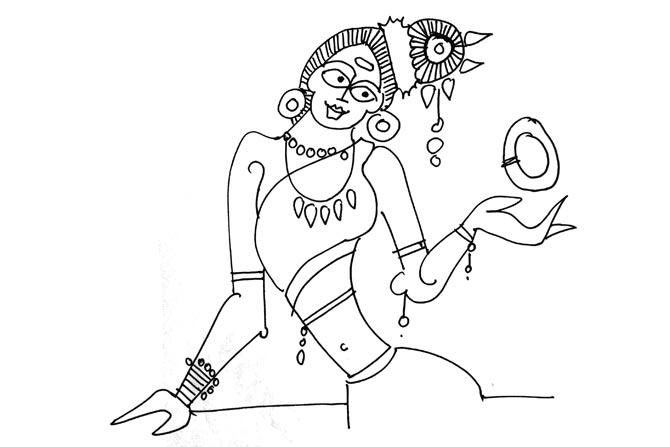Fifteen-hundred years ago, when the first Hindu temples started being built on the Gangetic plains, in the southern part of India, many great epics were composed in Tamil that tell us about different kinds of women: Shilapatikaram (Tale of the Anklet) tells the story of Kannagi, the chaste wife, and Madhavi, the courtesan; Manimekalai tells the story of Madhavi’s daughter, Manimekalai; and Kundalakeshi tells the story of a woman who loved a thief. These tales reveal much about how women were seen in those ancient times.

 Fifteen-hundred years ago, when the first Hindu temples started being built on the Gangetic plains, in the southern part of India, many great epics were composed in Tamil that tell us about different kinds of women: Shilapatikaram (Tale of the Anklet) tells the story of Kannagi, the chaste wife, and Madhavi, the courtesan; Manimekalai tells the story of Madhavi’s daughter, Manimekalai; and Kundalakeshi tells the story of a woman who loved a thief. These tales reveal much about how women were seen in those ancient times.
Fifteen-hundred years ago, when the first Hindu temples started being built on the Gangetic plains, in the southern part of India, many great epics were composed in Tamil that tell us about different kinds of women: Shilapatikaram (Tale of the Anklet) tells the story of Kannagi, the chaste wife, and Madhavi, the courtesan; Manimekalai tells the story of Madhavi’s daughter, Manimekalai; and Kundalakeshi tells the story of a woman who loved a thief. These tales reveal much about how women were seen in those ancient times.

Illustration/Devdutt Pattanaik
ADVERTISEMENT
Kannagi is the daughter of a merchant who marries Kovalan, son of another merchant. The marriage is a peaceful one, until Kovalan encounters the ravishing Madhavi, an accomplished dancer and courtesan, and is smitten by her beauty. He forgets about home and business and spends all his time with her until all his wealth runs out. One day, Kovalan realises Madhavi’s family is only interested in his wealth and only Kannagi, who pines for him, truly cares for him. So he returns home and the two, reduced to poverty, decide to start life afresh by moving to the city of Madurai. There, Kovalan is wrongly accused of stealing the queen’s anklet and, the king orders his beheading, without a proper investigation. A widowed Kannagi is so furious that she hurls her anklet at the king and the city of Madurai bursts into flames. Kannagi eventually is revered as the goddess, Pattini, the chaste wife. Madhavi, who loves Kovalan too, dies of heartbreak after giving birth to Manimekalai, who grows up to be a beautiful, skilled, educated and an erudite dancer. The Chola prince, Udayakumar, wants her but she chooses instead to become a Buddhist nun.
The most remarkable but lesser known story is that of Kundalakeshi, a merchant’s daughter who falls in love with a thief, called Kalan, who has been caught and paraded through the city streets. Kundalakeshi demands that her father fetch Kalan for her as husband. So the father petitions the king and secures the man for a husband paying a hefty sum for his release: his weight in gold and 81 elephants. Kundalakeshi and Kalan get married and live happily until the day, in a spirit of jest, Kundalakeshi refers to her husband as a thief. Kalan gets so upset that he decides to kill his wife. He takes her to the top of the mountain where he reveals her intention. She weeps and accepts her fate and begs that she be allowed to go around her husband three times, as a mark of respect and repentance. Kalan agrees and Kundalakeshi goes around him. As soon as she is behind him, she gives Kalan a push and it is he who tumbles down the mountain and dies. Then overcome by guilt, she turns into a nun. First a Jain nun, and eventually a Buddhist nun.
Three kinds of female protagonists emerge from these ancient Tamil epics: the chaste wife linked to only one man, the courtesan linked to many, the nun linked to none. Neither of them finds happiness with her man. And willy-nilly hierarchy emerges with the courtesan at the bottom of the pyramid, for she is associated with ‘base sexual desires’. There is conflict between the wife and the nun, the former embodying ‘regulated sexual desires’ and the latter embodying ‘no sexual desire’. Kundalakeshi cuts across all three categories: she is no courtesan but has uncontrollable sexual appetite indicated by her obsession for a convicted felon. She remains a faithful wife, though eventually she becomes husband-killer, and then a nun.
It is remarkable that Buddhist epics, which tend to focus on monasticism, paid so much attention to female sexuality. It refers to a different time in Indian history, long before modern prudery, that saw women very differently: not merely as objects of desire, but as subjects too.
The author writes and lectures on relevance of mythology in modern times. Reach him at devdutt@devdutt.com
The views expressed in these columns are the individual’s and don’t represent those of the paper.
 Subscribe today by clicking the link and stay updated with the latest news!" Click here!
Subscribe today by clicking the link and stay updated with the latest news!" Click here!







